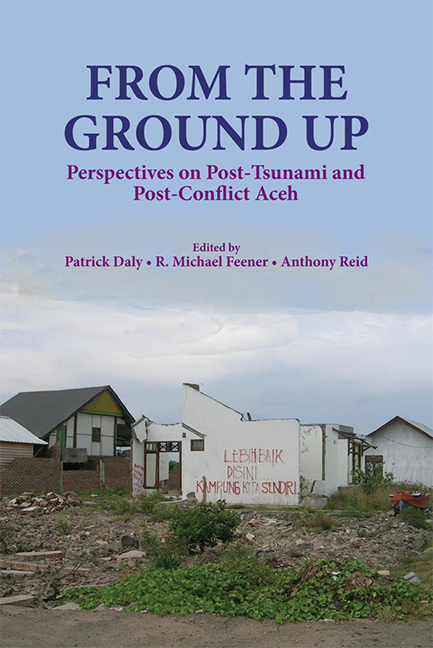Book contents
- Frontmatter
- Contents
- Preface
- List of Figures and Tables
- The Contributors
- Glossary and Abbreviations
- Introduction: Unpacking the Challenges of Post-2004 Aceh
- 1 The Sunda Megathrust: Past, Present and Future
- Part I Reconstruction Efforts
- Part II Conflict Resolution
- 9 Managing Risk: Aceh, the Helsinki Accords and Indonesia's Democratic Development
- 10 Making Peace Agreements Effective: The Aceh Monitoring Mission Experience
- 11 Justice and the Aceh Peace Process
- 12 Managing Peace in Aceh: The Challenge of Post-Conflict Peace Building
- Index
12 - Managing Peace in Aceh: The Challenge of Post-Conflict Peace Building
from Part II - Conflict Resolution
Published online by Cambridge University Press: 21 October 2015
- Frontmatter
- Contents
- Preface
- List of Figures and Tables
- The Contributors
- Glossary and Abbreviations
- Introduction: Unpacking the Challenges of Post-2004 Aceh
- 1 The Sunda Megathrust: Past, Present and Future
- Part I Reconstruction Efforts
- Part II Conflict Resolution
- 9 Managing Risk: Aceh, the Helsinki Accords and Indonesia's Democratic Development
- 10 Making Peace Agreements Effective: The Aceh Monitoring Mission Experience
- 11 Justice and the Aceh Peace Process
- 12 Managing Peace in Aceh: The Challenge of Post-Conflict Peace Building
- Index
Summary
INTRODUCTION
Unlike the previous two peace attempts, the Helsinki peace accord reached by the Government of Indonesia (GoI) and the Free Aceh Movement (GAM) in August 2005 appears to have a better chance of bringing an end to the separatist conflict in the Province of Nanggroe Aceh Darussalam (NAD). More than four years after the implementation of the agreement, peace in Aceh was still holding. After the conclusion of peaceful regional elections on 11 December 2006, the overall picture has become even more encouraging. For GAM, its decision in Helsinki to transform itself from an armed insurgency group into a political force within the Republic of Indonesia began to pay off when many former GAM leaders, including the candidate for governor Irwandi Yusuf, won the local elections. For the Government of Indonesia, the fruit of a political settlement to the conflict was evident when Irwandi Yusuf and Muhammad Nazar officially took the oath as the new governor and vice-governor of NAD Province on 8 February 2007, pledging allegiance to the Republic of Indonesia.
The Aceh peace process represents a remarkable example of a peaceful settlement of internal conflict in a democratizing country. However, because the conflict in Aceh is deep-rooted and multifaceted, factors that could derail the peace process have not disappeared entirely. The key challenge now for the Indonesian Government, the new Aceh government and the Acehnese is how to manage the difficult task of post-conflict peace-building in order to ensure that conflict does not recur in the future. This chapter analyses why the Helsinki peace accord, known as the Memorandum of Understanding (MoU), has so far worked well. In addition, the chapter also examines future challenges in post-conflict peace-building efforts. Three issues are critical in this regard: the challenge of governance, the progress of post-tsunami reconstruction and the imperative of a democratic political order in Aceh. Finally, the chapter draws some lessons that might be relevant to the resolution of other conflicts in the region.
- Type
- Chapter
- Information
- From the Ground UpPerspectives on Post-Tsunami and Post-Conflict Aceh, pp. 242 - 257Publisher: ISEAS–Yusof Ishak InstitutePrint publication year: 2012

